Advantages and Techniques of Elevated Bed Soil
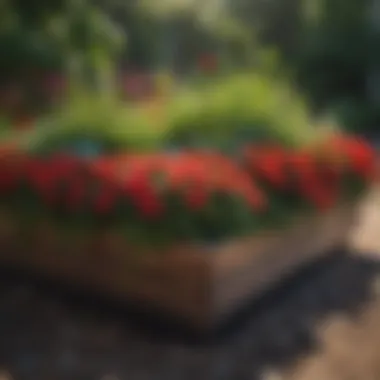
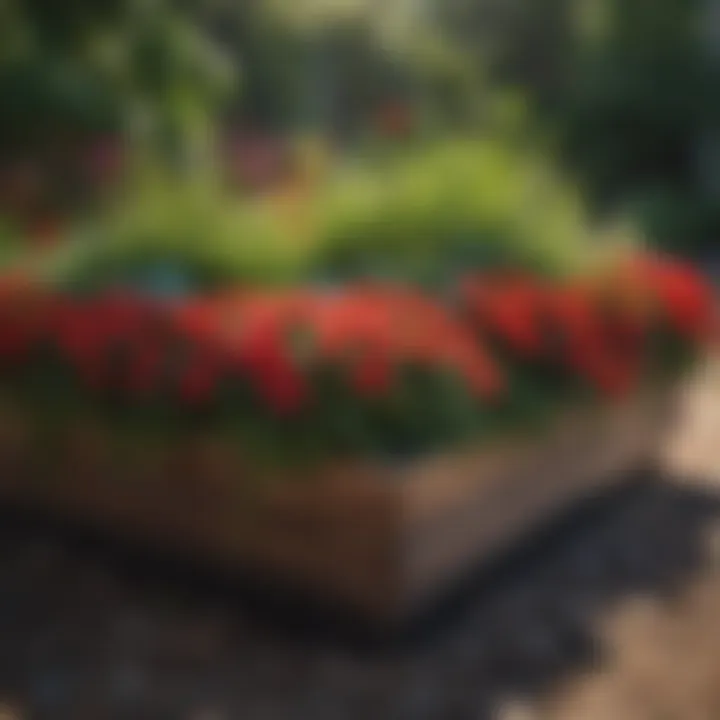
Intro
Elevated beds are becoming increasingly popular among garden enthusiasts and homeowners alike. They offer a wealth of advantages that go beyond mere aesthetics. Imagine stepping into your garden and being greeted by rows of lush vegetables and colorful blooms without having to bend down, all thanks to a little elevation. This could be the perfect solution for anyone, whether you have limited space or simply want to elevate your gardening game.
Not only do elevated beds enhance your gardening experience, but they also facilitate improved drainage, reduce soil compaction, and allow for better control over soil quality. This makes them particularly useful in diverse climates and settings, from urban backyards to expansive rural landscapes. Each elevated bed can be tailored to meet the specific needs of the plants within it, offering an adaptable solution for varying gardening ambitions.
The journey to understanding elevated bed soil is layered, from meticulously selecting the right materials and styles to mastering the techniques that keep these gardens thriving. We’ll explore not just the nuts and bolts of construction and maintenance, but also the creative flair that can make your garden a visual masterpiece. No matter if you are a seasoned gardener or just starting out, there’s something beneficial to glean from every aspect of elevated bed soil gardening.
Design Inspiration
Trending Styles
When it comes to elevated gardens, the design possibilities are as broad as they are exciting. You can opt for traditional wooden frames or go for something a bit more modern, like steel beds or concrete blocks. Each material brings its own flair and functionality.
- Classic Wooden Elevated Beds: Timber remains a favorite for its aesthetic appeal and organic feel. Choices like cedar or redwood not only look great but also resist decay, ensuring your invested time and money pays off.
- Metal Raised Beds: Galvanized steel offers a sleek, contemporary option. It can withstand the elements and is perfect for anyone wanting a more industrial look in their garden. The benefit here includes enhanced heat retention which can be vital for plants needing warmth.
- Concrete Blocks: For the builder at heart, concrete blocks provide a robust option that’s both durable and customizable. You can stack them to create various shapes and heights, allowing for artistic design while remaining functional.
Color Palettes
Color is another aspect worth considering. Elevated beds can be anything but dull. Some popular color palettes to consider:
- Earthy Tones: Browns, greens, and grays blend seamlessly into nature, promoting a calm and cohesive garden space.
- Bright and Bold: Don’t shy away from vibrant colors! A splash of red, yellow, or purple can bring lifefulness to your garden, especially when combined with colorful plants and flowers.
- Pastels: Soft shades uplift the area without overwhelming it, perfect for traditional gardens.
With these styles in mind, you can create not just functional spaces but also visually pleasing ones that captivate.
Practical Tips
Maintenance & Care
Keeping your elevated beds in tip-top shape isn't difficult, but it does demand some ongoing attention. Here are several key pointers to keep in mind:
- Watering: Always check the moisture level in the soil. Elevated beds can dry out faster than traditional gardens. Make sure to water adequately, especially during hot summer days.
- Soil Quality: Regularly inspect the soil. You’ll want a mix rich in organic matter to ensure plants receive the nutrients they need. Compost is often a gardener’s best friend here.
- Crop Rotation: Practicing crop rotation helps manage soil health. This means changing what you plant in each bed every year to avoid depleting specific nutrients.
Budgeting & Planning
Investing in elevated beds can vary widely in cost, depending on materials and size. Here's a breakdown of smart budgeting tips:
- Start Small: If you are new to this, begin with just one or two beds. This will let you gauge costs and learn before scaling up your efforts.
- DIY: If you have the skills, building your own frame can save a heap of cash. Plus, it adds a personal touch to your garden.
- Repurpose: Consider using old materials, like pallets or bricks. This can create a unique look and be budget-friendly.
By acknowledging the design and practical maintenance that come with elevated garden beds, you can maximize both the enjoyment and productivity of your gardening endeavors. Elevating your gardening expertise is, ultimately, about blending creativity with practicality.
Preamble to Elevated Bed Soil
Elevated bed soil isn't just a trendy gardening fad; it's a practical approach that can revolutionize how we cultivate our plants. Homeowners, gardening enthusiasts, and even those new to the planting game are starting to recognize the numerous benefits associated with this method. The key to understanding elevated bed soil lies in its capacity to create an optimal environment for plant growth.
In essence, these beds provide enhanced drainage, improved accessibility, and even a longer growing season. As we delve deeper into the world of gardening, it becomes increasingly clear that having control over soil quality and structure can lead to healthier plants and more robust yields. Hence, this section aims to unravel the core aspects of elevated bed soil—setting the stage for a deeper dive into its benefits and techniques.
Definition and Overview
Elevated beds, often referred to as raised beds, are garden plots that are built up above the surrounding ground level. They can be constructed from a variety of materials, including wood, stone, and metal, and filled with a specially selected soil mix. This increased height provides numerous advantages, such as better drainage and reduced soil compaction. While the common belief is that raised beds are ideal for vegetables, they’re versatile enough to accommodate flowers, herbs, and even native plants. The defining factor here is how they create a favorable microclimate for whatever you choose to cultivate.
Historical Context
The concept of elevated gardening isn't new; it has ancient roots that stretch back across cultures and centuries. Early civilizations, like the Romans and the Chinese, employed similar techniques to maximize crop yields and manage soil conditions. The terraced fields of the Andes or the intricately designed gardens of ancient Egypt are prime examples of how people adapted their growing methods to their environments. Fast forward to today, many urban gardeners are rediscovering these age-old practices to enhance their gardening prowess, proving that good ideas never truly go out of style.
This historical perspective not only highlights the resilience of elevated gardening but also underscores its continued relevance in contemporary practices, particularly as more folks look to their backyards as a means of sustainable food production.
Benefits of Elevated Beds
Elevated bed gardening opens up a plethora of advantages for both seasoned gardeners and newcomers alike. Delving into the various benefits illustrates not just the practicality but also the transformative potential of this gardening technique. The elevated nature of these beds promotes better moisture retention, reduction in soil compaction, and ease of access, paving the way for a more enjoyable gardening experience.
Improved Drainage
One of the primary benefits of elevated beds is their ability to provide excellent drainage. Traditional gardening often encounters issues like waterlogging or poor drainage, especially in heavy clay soils. Elevated beds combat this by allowing water to freely drain away, reducing the risk of root rot and promoting healthy plant growth. This benefit is particularly notable in climates with heavy rainfall, where inundated soil can pose a serious threat. By constructing an elevated bed, you create an environment where roots can get the oxygen they need without drowning in excess water.
Enhanced Soil Quality
Elevated beds often lead to better soil quality compared to ground-level gardening. Since you have the autonomy to choose the soil mix, you can tailor it to fit the specific needs of your plants. Utilizing a mix rich in organic matter increases the nutrient content and improves soil structure. Soils in raised beds tend to warm up quicker in the spring, promoting earlier plant growth. Additionally, maintaining this soil often proves easier, as you can amend it with compost and other nutrients throughout the growing season.
Accessibility
Benefits for the Elderly
Accessibility is a crucial factor in gardening that’s often overlooked. For the elderly, elevated beds can alleviate the strain of bending down. The simple act of gardening can lead to discomfort or injury for those with mobility issues. Elevated beds provide a level of comfort through their height, allowing for a more enjoyable experience. This thoughtful approach can foster a continued engagement in gardening, promoting physical activity and mental well-being. The ease of access significantly contributes to enhancing the overall gardening experience.
Convenience for Disabled Gardeners
For disabled gardeners, the convenience of elevated beds cannot be overstated. Elevated beds can be designed to accommodate wheelchairs and other mobility aids, ensuring inclusivity in gardening. This design allows gardeners to tend to their plants without the need to navigate uneven ground or worry about falling. Additionally, many elevated beds can be fitted with features such as wider edges for tool placement or seating, making them a practical choice for those requiring extra support while gardening.
Prolonged Growing Season
Elevated beds also provide the benefit of a prolonged growing season. Due to their height and improved drainage, these beds warm up more quickly in spring, allowing for an earlier planting date. Not just that, but they can also moderate temperature fluctuations, which is advantageous in regions with weather variances.
Impact of Temperature Regulation
The impact of temperature regulation in elevated beds is significant. By creating a microclimate, plants can grow more robustly and with less stress from temperature shocks. Elevated beds tend to retain heat longer in the evenings and during cooler months, giving plants the warmth they need to thrive. This can lead to a greater diversity of crops harvested throughout the year.
In summary, elevated beds offer a rich array of benefits, from improved drainage to enhanced accessibility, making them a fantastic option for diverse gardeners.
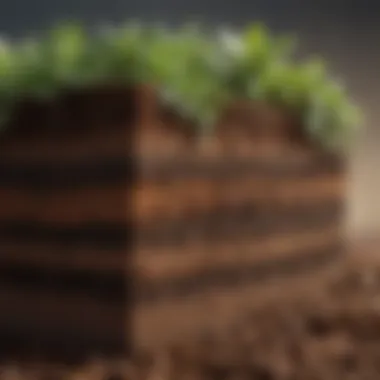
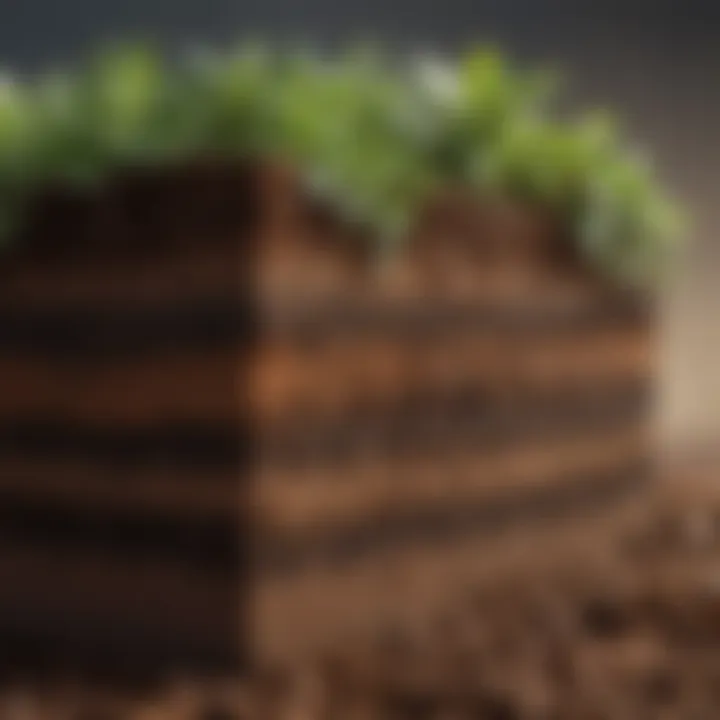
Embracing the use of elevated beds can drastically change the gardening landscape, both literally and metaphorically.
Types of Elevated Beds
Understanding the various types of elevated beds is crucial for anyone embarking on their gardening journey. Each design offers distinct benefits and unique considerations that cater to different gardening needs and preferences. Exploring these options not only helps gardeners maximize their space but also enhances functionality and efficiency in the growing process. Here, we delve into the most common types of elevated beds and discuss their features, advantages, and best use cases.
Traditional Wooden Raised Beds
Traditional wooden raised beds are often the first choice for numerous gardeners. They tap into a rustic aesthetic, evoking a sense of familiarity and nostalgia. Typically constructed from rot-resistant woods like cedar or redwood, these beds provide a sturdy framework for growing a variety of plants.
Advantages of wooden raised beds include:
- Natural Insulation: Wood has excellent insulating properties. This can lead to warmer soil in cooler climates, promoting early plant growth.
- Customizable Shape and Size: Homeowners can tailor these beds to fit their yard dimensions or personal aesthetics.
- Biodegradable: When they eventually deteriorate, wooden beds break down naturally, enriching the soil.
However, they do require regular maintenance, including sealing and possible replacement over the years, to combat weather-induced wear and tear.
Metal and Fabric Options
Metal raised beds have surged in popularity due to their durability and modern design. Constructed from materials like galvanized steel or aluminum, they can resist pests and rotting. Similarly, fabric beds are gaining traction for their lightweight and flexible nature. Often made from breathable fabric, they can be folded and stored easily.
Benefits of metal and fabric options:
- Longevity: Both metal and fabric options provide a longer lifespan compared to wooden beds, eliminating the frequent need for replacement.
- Drainage: The construction of fabric beds improves drainage and aeration. This is particularly beneficial for plants sensitive to overwatering.
- Fashionable Appeal: The sleek, contemporary look of metal beds contributes to modern garden designs.
While durable, one should consider the potential for heat retention in metal beds, especially during scorching summer months, which might require some extra care concerning plant watering.
Modular and Stackable Designs
In recent years, modular and stackable designs have come into focus. These beds allow gardeners to create unique layouts and customize their growing areas. They can be rearranged or expanded as needed, making them excellent for evolving gardens.
Adaptability for Small Spaces
A key aspect of modular and stackable designs is their ability to fit into limited spaces. Whether you have a compact yard or a balcony, these beds cater to your needs without compromising on gardening opportunities. One standout characteristic of these designs is their vertical stackability. This allows for more plants to flourish in a smaller footprint.
- Space Efficiency: By utilizing vertical space, gardeners can optimize their growing area, ideal for urban gardening where ground space is limited.
- Accessibility: Different configurations can support a variety of plant types while keeping them accessible for maintenance.
- Unique Features: Some models come with integrated irrigation systems, maximizing water usage and minimizing waste.
While the versatility of modular beds is compelling, potential downsides may include stability concerns if stacks become too high, and they might require more frequent monitoring for water and nutrient levels.
In sum, selecting the right type of elevated bed can significantly influence the gardening experience, enabling gardeners to make the most of their natural environments. Understanding the benefits and intricacies of traditional wooden, metal, fabric, and modular designs is an essential step in crafting a successful garden.
Materials for Elevated Beds
Understanding the materials suitable for constructing elevated beds is essential for creating a thriving garden. The choice of materials directly influences the longevity, aesthetics, and effectiveness of the bed. Whether using sustainable wood, recycled options, or synthetic liners, each material comes with its unique attributes, benefits, and potential drawbacks. Selecting the right materials can enhance the functionality of the elevated bed, ensuring better plant growth while also aligning with environmental considerations.
Sustainable Wood Choices
Cedar vs. Pine
When it comes to sustainable wood choices for elevated beds, cedar and pine commonly surface as contenders. Cedar is often favored for its natural resistance to rot and pests. The oils within cedar help it withstand the elements, extending its lifespan significantly compared to other woods. This characteristic makes cedar a popular, albeit pricier, option. In contrast, pine is generally more budget-friendly and widely available but lacks the same durability against moisture and insects. However, its suitability improves significantly with treatment processes; treated pine can serve as a good alternative, balancing cost and performance.
A significant aspect to consider here is the unique feature of each: cedar retains its integrity even under harsh conditions, while untreated pine will degrade faster. Therefore, while both types can be viable, cedar might prove better for someone looking for long-term use without continual replacement.
Environmental Considerations
The choice of wood material also brings us to critical environmental considerations. When sourcing wood for elevated beds, it’s imperative to opt for sustainably harvested options. This means considering wood that comes from responsibly managed forests, reducing the impact of deforestation. Choosing local suppliers can also reduce carbon footprints associated with transportation of materials.
Selecting sustainably sourced cedar or even reclaimed wood can enhance the ecological footprint of your garden. Not only does it make for a healthier environment, but it emphasizes a conscious effort towards sustainability, making it an increasingly appealing choice for gardeners who prioritize ecology in their practices.
Recycled and Composite Materials
Recycled and composite materials serve as alternatives that promote sustainability while addressing some challenges of traditional materials. Composite materials, often made from a mix of recovered wood fibers and plastic composites, deliver durability and low maintenance. They don't rot, warp, or splinter, which makes them attractive to many gardeners. Moreover, using recycled materials can help reduce landfill waste, thereby serving a dual purpose of construction and ecological responsibility.
Some common composite options include synthetic lumber, which offers the rustic appearance of wood without the typical risks associated with decomposition. Best of all, they can last for many years while requiring minimal care. However, a potential downside is that they may not convey the same organic feel as natural wood, which can affect the overall aesthetic of the garden.
Natural vs. Artificial Liners
Finally, when constructing elevated beds, the decision between natural and artificial liners is worth noting. Natural options such as burlap or untreated fabric offer benefits like breathability and are entirely biodegradable. They allow for excellent drainage while enhancing soil health as they decompose over time.
On the other hand, artificial liners made from materials like plastic offer durability and require less upkeep. These liners effectively prevent soil erosion and can be waterproof, keeping your elevated bed’s soil intact. However, they may hinder drainage if not properly designed and can impact soil health if not rotated or replaced over time.
In summary, the materials selected play a pivotal role in defining the success and environmental impact of elevated beds. Whether choosing wood, recycled materials, or deciding on liners, each choice should be made with careful consideration of their long-term effects on the garden ecosystem.
Soil Preparation Techniques
Soil preparation is a pivotal aspect of creating effective elevated beds. This process ensures that the plants have a nourishing environment to thrive in. A thoughtful approach to soil preparation can vastly improve plant health, yield, and resilience against pests and diseases. Several considerations enhance your elevated garden’s overall performance and sustainability.
Selecting Appropriate Soil Mix
Choosing the right soil mix can make or break your gardening experience. It's not just about grabbing any old bag of potting soil off the shelf. Effective soil blending should balance texture, nutrients, and moisture retention to create an ideal growing environment. For elevated beds, a mix that typically includes a blend of topsoil, compost, and peat moss can work wonders.
Each of these components fulfills a specific role. Topsoil provides the foundation, compost enriches the soil with nutrients and beneficial microorganisms, while peat moss enhances moisture retention. If you aim to grow vegetables, look for a mix specifically designed for edibles, as this blends nutrients suited for faster growth.
Layering for Optimal Drainage
Proper drainage is essential for any elevated bed. Without it, you could easily end up with a soggy mess that's lethal for most plants. A good technique is layering your soil. Start with rocks or gravel at the bottom to facilitate drainage, followed by a layer of coarse sand. This base helps prevent water from accumulating in the root zone, where it can lead to root rot. Next, fill the space with your chosen soil mix, keeping in mind that different layers also help balance the water retention zones, ensuring that plants receive the right amount of hydration.
Incorporating Organic Matter
Types of Compost
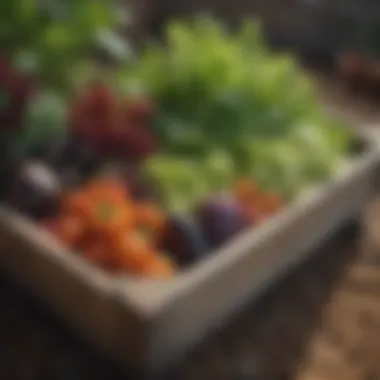
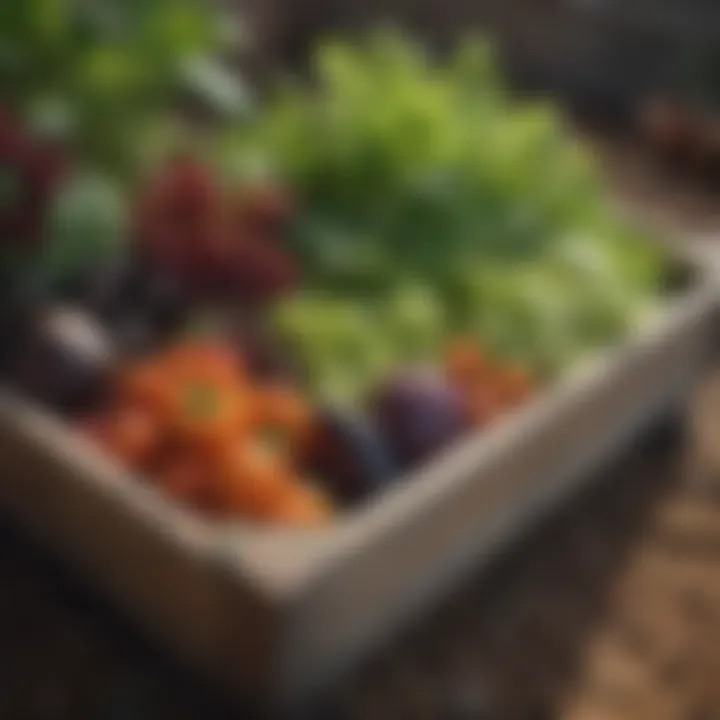
Incorporating compost into your elevated bed is like adding a secret ingredient to a favorite recipe; it enhances growth remarkably. Different types of compost offer unique benefits. Homemade compost, for example, often has a wide variety of nutrient profiles that cater to many plants. On the other hand, store-bought compost might be easier to use for those short on time. While it usually has consistent quality, it can lack certain local microorganisms beneficial for soil health.
The key characteristic of compost is its ability to improve soil structure. When compost is mixed into your soil, it helps increase aeration and water retention. However, a disadvantage might be that some commercially produced compost can contain additives or fillers that don’t contribute as much to soil health.
Benefits of Mulching
Mulching can also play a significant role in maintaining the health of your elevated beds. Not only does it look neat and tidy, but it offers several advantages. For one, it helps retain soil moisture and suppress weeds, which gives your plants a fighting chance against competition for nutrients. Organic mulch, like wood chips or straw, breaks down over time, adding even more nutrients back into the soil.
A unique aspect of mulching is its ability to moderate soil temperature. In warm weather, it keeps the roots cooler, which is crucial for sensitive plants. However, it can sometimes attract pests if not managed correctly, so watch out for unwanted critters that may decide to make a home in your mulch.
Ultimately, soil preparation techniques play a vital role in the success of elevated bed gardening, boosting plant health and yielding fruitful harvests.
Employing these strategies ensures that your elevated garden will not only look good but also produce robust and healthy plants.
Plant Selection Strategies
Choosing the right plants for elevated beds is crucial not only for aesthetics but also for maximizing yield and ensuring that your garden thrives. It’s all about understanding the environment you are creating and selecting species that complement each other while thriving in those conditions. This section digs into compatible plant species and emphasizes the need for strategic planning in your garden.
Compatible Plant Species
Annuals vs. Perennials
When comparing annuals and perennials, the primary distinction lies in their life cycles. Annuals, like sunflowers and tomatoes, complete their life cycle in one season. They offer vibrant bursts of color and harvest each year. Bouncing back to life each spring isn’t on their agenda, instead, they deliver quick results and immediate gratification.
Perennials, on the other hand, are the long-term players in any garden. Plants like lavender and daylilies return year after year, contributing to stability and an ever-evolving landscape. Their key characteristic is resilience, as they adapt to their environment and often require less maintenance once established.
The advantage of planting annuals in elevated beds is their rapid growth, providing quick harvests. However, they demand more frequent replanting and may lead to seasonal soil exhaustion. Conversely, while perennials offer lower maintenance and enrich soil, they often need more time to establish and bear fruits or blooms.
"Choosing the right plants is like picking the cast for a play; each role should enhance the overall performance."
Vegetable Varieties
In terms of vegetables, selecting right varieties can greatly influence not just yield but also the overall success of an elevated bed garden. Options such as climbing beans, which utilize vertical space efficiently, or leafy greens like spinach that can be harvested multiple times, are ideal for cramped quarters.
One unique aspect of vegetable varieties is their adaptability. For example, dwarf varieties of tomatoes can thrive in smaller spaces, enabling gardeners to enjoy home-grown produce without a vast area. These plants can be particularly effective when combined with companion planting strategies, as they often support each other in terms of growth and pest deterrence.
Each vegetable comes with its challenges; some can be quite heavy feeders, needing more nutrients and water, which requires an understanding of soil health. Balancing these needs can sometimes prove tricky but can be very rewarding when harvest time rolls around.
Considerations for Companion Planting
Companion planting is the art of grouping plants together for mutual benefit. Some plants deter pests, while others provide shade or support for taller plants. Considerations for companion planting should include the following:
- Pest Management: Some plants, such as marigolds, repel harmful insects which can benefit neighboring crops.
- Nutritional Support: Legumes, for example, fix nitrogen in the soil, enriching it for heavy feeders like corn and peppers.
- Space Utilization: Tall plants can offer shade to shorter ones that prefer less sun, ensuring efficient use of the vertical space typical in elevated beds.
Strategically pairing plants, therefore, enhances productivity while promoting a healthy ecosystem within your elevated bed garden. Observing and experimenting with plant relationships can lead to greater insights into what grows best together, which can be both enjoyable and beneficial in the long run.
In summary, understanding plant selection strategies is fundamental for a flourishing elevated bed garden. Whether you lean towards the quick results of annuals or enjoy the robustness of perennials, thoughtful planning and implementation of companion planting can make a world of difference in achieving a successful and thriving garden.
Maintenance Requirements
In the world of elevated bed gardening, maintenance is the unsung hero. It quietly ensures that everything runs smoothly above ground while significantly contributing to the overall health and productivity of your plants. Without proper maintenance, the efforts put into soil preparation, plant selection, and even the very construction of the raised beds could end up going south.
Taking care of the plants and the bed structure is essential for a flourishing garden. Let's look closely at three main pillars that make up regular maintenance: watering, fertilization, and pest management.
Watering Techniques
Watering isn't just about turning on the hose and letting it flow. It's about timing, quantity, and technique. Generally, plants in elevated beds might need more frequent watering than their in-ground counterparts due to better drainage and increased exposure to sun and wind. Here are some effective methods to keep those beds hydrated:
- Soaker Hoses: These hoses deliver water directly to the root zones, ensuring that plants drink deeply without wasting water on evaporation.
- Drip Irrigation: This method provides a slow and steady supply, reducing the risk of overwatering and the development of root rot.
- Rainwater Harvesting: Collecting rainwater can be a sustainable way to keep gardens hydrated. Installing barrels beneath gutters is perfect for this.
No matter the technique, monitoring soil moisture is critical. A simple finger test or a moisture meter can help gardeners strike the right balance.
Fertilization Protocols
Whether you're growing tomatoes or petunias, nutrients matter. Fertilizing an elevated bed helps replenish essential elements for food production and growth. The three core components to focus on are nitrogen, phosphorus, and potassium.
- Organic Fertilizers: Compost and well-rotted manure are great options for anyone seeking to boost their soil without harsh chemicals. They release nutrients slowly, encouraging steady plant growth.
- Liquid Fertilizers: These can provide a quick nutrient boost, especially during growing periods. Be cautious, though; too much can weaken plants.
- Timing: Application should align with your planting schedule. Early spring feedings as plants wake up and another during mid-summer can ensure they thrive.
Pest and Disease Management
Pests can be the bane of any gardener's existence. But with knowledge and proactive actions, it's possible to keep them at bay.
Organic Solutions
Opting for organic solutions isn't just trendy; it's often the best route for a healthy garden and ecosystem. These methods not only help manage pest problems but also encourage biodiversity around your garden. Essential oils, insecticidal soaps, and diatomaceous earth are some examples that effectively mitigate unwanted pests. The benefit? They're generally safer for both pollinators and humans.
Preventative Measures
Staying a step ahead of pests requires strategies that keep them from becoming a problem in the first place. Crop rotation, companion planting, and introducing beneficial insects can work wonders. Also, routine inspections will catch any issues early. Using row covers or nets can keep pests at bay but ensure they're breathable to allow airflow.
Overall, the combination of appropriate watering techniques, mindful fertilization practices, and proactive pest management creates a robust foundation that keeps elevated beds thriving.
Key Takeaway: Regular maintenance, requiring careful watering, thoughtful fertilization, and vigilant pest management, is vital to ensure elevated bed gardening flourishes.
Ecological Considerations
The ecological implications of elevated bed soil are worth discussing in depth as they intertwine with sustainability and environmental health. Using elevated beds not only reshapes the way we think about gardening but also influences local ecosystems, promoting functionalities that enhance biodiversity and generally uplift soil health.
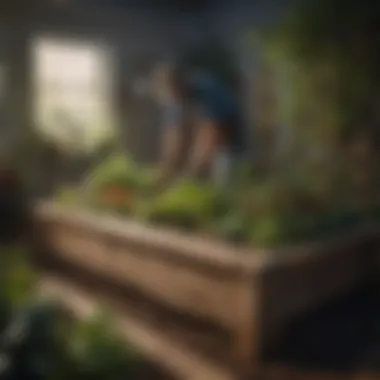

Elevated beds create a unique microenvironment conducive to nurturing a variety of plant species. They can effectively support the presence of beneficial insects and other wildlife which, in turn, are essential for pollination and pest management. More than just a visual enhancement to the garden, these beds serve as thriving ecosystems that demonstrate the delicate balance of nature in action.
Biodiversity and Pollinator Support
The critical role of biodiversity in gardening cannot be overstated. Elevated beds can provide a diverse range of plants that flourishes in distinct layers, contributing to habitat for various animals.
- Plant Variety: Taller plants can be positioned towards the back, while smaller ones can fill in the front. This arrangement not only maximizes space but also supports a wider array of plant life.
- Habitat Creation: Among these vibrant plants, creatures like bees, butterflies, and ladybugs find sanctuary. This adds a layer of functionality to the elevated beds—promoters of pollination ensure that fruits and veggies have the best chance to thrive.
- Microclimate: The physical elevation of these beds can create a microclimate that benefits certain plants which might struggle in traditional settings. For example, heights can retain warmth, extending growing seasons and helping out-of-season blooms flourish.
"Creating diverse habitats through elevated beds encourages a flourishing relationship between plants and the pollinators they depend on."
Soil Health and Sustainability
Elevated beds also significantly impact soil health and sustainability practices. The way these beds are constructed allows for better control over the soil composition, enhancing its quality over time and promoting a richer, healthier environment for plants.
- Soil Quality Control: By utilizing specific soil mixes tailored for elevated beds, gardeners can construct an optimal growing medium. This ensures that the right balance of nutrients is available, without the restrictions often faced in traditional garden plots.
- Prevent Erosion: Elevated construction helps minimize soil erosion, enhancing sustainability by maintaining the nutrient-rich topsoil that many plants crave. Without losing valuable soil, gardens can be both productive and environmentally friendly.
- Compaction Resistance: Elevated beds also mitigate issues like soil compaction—a problem prevalent in ground-level gardens. Healthy soil structure allows air, water, and nutrients to flow freely, promoting robust plant growth.
In sum, when we consider ecological factors in designing gardens with elevated beds, we're not merely planting seeds; we're fostering resilient ecosystems that prioritize biodiversity and healthy soil for generations to come.
Case Studies and Real-World Applications
The understanding of elevated bed soil extends beyond mere theory and practice; it is also illuminated through various real-world applications. Case studies serve as a vital part of any comprehensive exploration. They not only illustrate the benefits but also highlight the diverse contexts in which these techniques can prove advantageous. By examining urban gardening initiatives and community gardens, we can appreciate the profound impact that elevated beds have on people's lives and the environment. This section sheds light on how elevated beds enhance gardening accessibility and productivity, particularly in areas where space and resources are limited.
Urban Gardening Initiatives
In urban environments, where space is often as scarce as gold dust, elevated beds have become lifesavers for green thumbs. Imagine a bustling city, with high rises towering over bustling streets, and yet, there’s a community thriving with greenery. Urban gardening initiatives leverage elevated bed soil to create vibrant patches of green in concrete jungles. These initiatives create additional symbiosis between nature and urban spaces by introducing gardens on rooftops, balconies, and tiny backyards.
Benefits of urban gardening initiatives include:
- Space Utilization: Elevated beds maximize the limited space, allowing more plants to flourish vertically. They give the opportunity to grow food where it might not have been feasible otherwise.
- Environmental Impact: Using elevated beds can improve local air quality and promote biodiversity. They provide a haven for pollinators in urban settings, which is crucial for ecosystem balance.
- Community Engagement: Such initiatives often foster a sense of community. Neighbors gather to maintain plots, share tips, and even harvest together, strengthening connections in densely populated areas.
The project in Brooklyn known as the "Green Roof Project" exemplifies urban gardening's brilliance. This initiative transformed an unused rooftop into a series of elevated beds, significantly enhancing local biodiversity while providing fresh produce to the community. The newly created green space has contributed positively to residents' mental health, as they find solace in tending to their plants amidst the city’s hustle and bustle.
Community Gardens
Think of community gardens as the lifeblood of neighborhoods. They are places of education, collaboration, and sustainability. Elevated beds within community gardens have made gardening more approachable, especially for newcomers. By implementing elevated soil systems, these gardens tackle some of the common challenges associated with traditional gardening, such as poor soil conditions and physical accessibility limitations.
Some key aspects of community gardens utilizing elevated beds include:
- Inclusivity: Elevated beds make gardening accessible for individuals of all ages and abilities. They eliminate some common barriers associated with gardening in ground soil, such as bending down, which can be hard for the elderly or those with disabilities.
- Soil Quality Management: Community gardens often face issues like contaminated soil or poor drainage. Elevated beds allow gardeners to control the soil quality precisely, ensuring healthy growth for vegetables and flowers alike.
- Educational Opportunities: Many community gardens focus on educating participants about sustainable practices. Elevated beds become great laboratories for hands-on learning, where people can experiment with new plants and techniques.
Indicators of success are visible in the Madison Community Garden in Wisconsin. They implemented elevated beds with recycled materials, turning an abandoned lot into a thriving workspace. The garden not only serves as a productive outlet for locals seeking fresh produce but also hosts workshops and seminar series focused on sustainable gardening practices.
In the grand tapestry of gardening, elevated bed soil is undoubtedly a thread that weaves through diverse landscapes, communities, and experiences. Its adaptability and utility shine in urban initiatives and community gardens—telling a narrative of connection, sustainability, and innovation in horticulture.
Challenges and Solutions
In the realm of gardening, particularly when using elevated bed soil, challenges often arise that can deter even the most passionate homeowners and gardening aficionados. Understanding these challenges is crucial not just for overcoming them but also for maximizing the benefits of elevated gardening setups.
When you’re gardening in an elevated bed, factors such as limited space, harsh climate conditions, and the complexities of soil management come into play. Identifying these issues early can lead to practical solutions that ensure a thriving garden environment. This section will explore some common challenges and offer thoughtful strategies to tackle them, making sure your elevated beds aren’t just functional but also flourishing.
Dealing with Limited Space
One of the pressing concerns many gardeners face is the issue of limited space. This is especially pertinent for urban dwellers who often find themselves with cramped yards or even no backyard at all. Elevating your gardening efforts can provide a unique solution to this predicament.
Vertical Gardening Techniques
Vertical gardening techniques stand out as an efficient response to limited space. Essentially, this approach involves growing plants upwards rather than outwards. By utilizing walls, trellises, and even vertical planters, gardeners can maximize their gardening footprint without needing additional horizontal space.
Key characteristics of vertical gardening include:
- Space Optimization: The upward growth allows for a greater variety of plants in small areas.
- Aesthetics: Vertical gardens can transform bland walls into vibrant green spaces, enhancing any area.
One unique feature of vertical gardening is its ability to create microclimates. Plants positioned on a vertical surface can benefit from different light exposures, moisture retention, and airflow compared to traditional horizontal beds. However, this technique comes with its disadvantages as well. It often requires more frequent watering, as vertical systems can dry out quicker. Also, the structural support must be sturdy enough to hold the weight of mature plants, which is something to consider when planning.
Climate Considerations
Every gardener knows that climate isn't just a casual aspect of gardening; it plays a pivotal role in what you can grow, how successful your elevated beds will be, and how much upkeep they will require. Different climates have their own sets of challenges that can impact your elevated bed gardening.
For instance, in arid climates, soil moisture retention becomes a critical issue. Elevated beds can dry out more quickly than ground soil due to increased exposure to sunlight and wind. Solutions such as incorporating organic mulch or using water-retentive gels can mitigate this problem. Conversely, in areas with heavy rainfall, elevated beds can help alleviate drainage issues, but gardeners must be cautious about soil erosion and nutrient leaching. Regular monitoring and mulching can assist in keeping the soil intact.
In a nutshell, adapting to climate considerations while managing elevated beds is a balancing act; however, with the right strategies, including selection of appropriate plant varieties and soil amendments, even the most challenging conditions can be navigated.
"Challenges are what make life interesting; overcoming them is what makes life meaningful."
By understanding the specific challenges and solutions in elevated bed gardening, you can transform potential setbacks into opportunities for plant growth and success.
Closure
Gardening may often be viewed through a prism of practicality, yet the art of cultivating plants, particularly through the use of elevated beds, transcends mere aesthetics or convenience. By integrating elevated bed soil into one’s gardening practice, several notable benefits emerge, reinforcing why this approach deserves consideration.
Summary of Key Points
Elevated beds offer several advantages:
- Improved Drainage: By being raised off the ground, these beds allow excess water to escape easily, which can be a lifesaver for plant roots.
- Enhanced Soil Quality: Ensuring a nutrient-rich environment is easier because gardeners can control what goes into these beds.
- Accessibility: Elevated beds are a boon for those with mobility challenges, allowing easy reach without the necessity to bend down excessively.
- Prolonged Growing Season: Being elevated helps maintain warmer soil temperatures in cooler climates, giving plants an early start.
In addition to offering gardeners a more manageable approach to planting, elevated beds can act as a sanctuary for biodiversity, supporting various species and encouraging a healthy ecosystem around the garden. They are especially favorable in urban settings, where land may be scarce and soil quality might be less than ideal.
Future Directions in Elevated Bed Gardening
The future of elevated bed gardening looks promising as more individuals seek sustainable practices. As awareness grows, it is likely that the following trends may take root:
- Innovative Materials: With technology, we might see more environmentally-friendly materials that could change how we build elevated beds.
- Smart Gardening: Integrating sensors to monitor soil health and moisture could lead to hands-off gardening for busy folks.
- Community Engagement: Urban spaces might see the rise of community-managed elevated beds, allowing collective efforts to enhance local food production and beautify neighborhoods.
As we move forward, embracing elevated bed gardening can be instrumental in encouraging creativity, collaboration, and sustainability. The adaptability and multifaceted benefits of elevated beds make them an easy solution for gardeners of all levels, ensuring that the practice continues to flourish in various settings.















